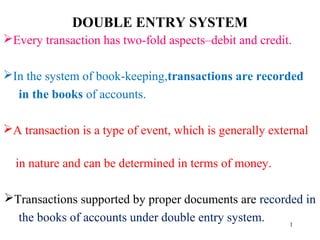
Chapter 1 journal
- 1. DOUBLE ENTRY SYSTEM Every transaction has two-fold aspects–debit and credit. In the system of book-keeping,transactions are recorded in the books of accounts. A transaction is a type of event, which is generally external in nature and can be determined in terms of money. Transactions supported by proper documents are recorded in the books of accounts under double entry system. 1
- 2. To analyse the dual aspect of each transaction, two approaches can be followed: (1) Accounting Equation Approach. (2) Traditional Approach. 2
- 3. (1) Accounting Equation Approach. Relationship of assets with that of liabilities and owners' equity in the equation form is known as 'Accounting Equation'. Due to Double Entry concept each transaction affects changes in assets, liabilities or capital in such a way that an accounting equation is completed and equated. 3
- 4. The contribution by the owner is termed as capital; the borrowings are termed as loans or liabilities. LIABILITIES Whenever the loan is repayable in the short-run it is called short-term loan or liability If the loan is repayable within 4 or 5 years or more, it would be termed as long term loan or liability. Liabilities relating to credit purchase of merchandise are called trade creditors, and for other purchases and services received on credit as expense creditors.(These are also termed as current liabilities.)
- 5. ASSETS Two types of assets– Fixed Assets and Current Assets Owner's claim (Equity ) implies :- Capital invested + Profit - Loss. 5
- 6. Equation: Equity + Liabilities = Assets OR Equity = Fixed Assets + Long-Term Liabilities + Current Assets - Current Liabilities 6
- 7. 2) TRADITIONAL APPROACH Transactions in the journal are recorded on the basis of the rules of debit and credit only. Transactions are classified in three groups: (i) Personal transactions. (Personal Accounts) (ii) Transactions related to assets and properties. (Real Accounts) (iii) Transactions related to expenses, losses, income and gains. (Nominal Accounts) 7
- 8. CLASSIFICATION OF ACCOUNTS (i) Personal Accounts Natural personal accounts: It relates to transactions of human beings like Ram, Rita, etc. Artificial (legal) personal account: For business purpose, business entities are treated to have separate entity. They are recognised as persons in the eye of law for dealing with other persons. For example:Government, Companies (private or limited), Clubs,Co-operative societies etc. Representative personal accounts: These are not in the name of any person or organisation but are represented as personal accounts. For example: outstanding liability or prepaid account, capital account, drawings account.8
- 9. (ii) Impersonal Accounts Accounts which are not personal: Real Accounts : Accounts which relate to assets of the firm but not debt. For example, accounts regarding land, building, investment, fixed deposits etc., are real accounts. Nominal Accounts Accounts which relate to expenses, losses, gains, revenue, etc. like salary account, interest paid account, commission received account. The net result of all the nominal accounts is reflected as profit or loss which is transferred to the capital account. Nominal accounts are, therefore, temporary. 9
- 10. GOLDEN RULES OF ACCOUNTING Personal account is governed by : Debit the receiver Credit the giver Real account is governed by : Debit what comes in Credit what goes out Nominal account is governed by : Debit all expenses and losses Credit all incomes and gains 10
- 11. Nature of Account Title of Account Traditional Approach Accounting Equation (a) Building Real Asset (b) Purchases Real Asset (c) Sales Nominal(R) Temporary Capital (R) (d) Bank Deposit Personal Asset (e) Rent Nominal (E) Temporary Capital (E) (f) Rent Outstanding Personal Liability (g) Cash Real Asset (h) Adjusted Purchases Nominal (E) Temporary Capital (E) (i) Closing Stock Real Asset (j) Investment Real Asset (k) Debtors Personal Asset 11
- 12. Title of Account Traditional Approach Accounting Equation (l) Sales Tax Payable Personal Liability (m) Discount Allowed Nominal (E) Temporary Capital (E) (n) Bad Debts Nominal (E) Temporary Capital (E) (o) Capital Personal Capital (p) Drawings Personal Temporary Capital (D) (q) Provision for dep. Real Asset (r) Interest receivable Personal Asset (s) Rent received in adv. Personal Liability (t) Prepaid salary Personal Asset (u) Provision for bad and doubtful debts Personal Asset (v) Bad debts recovered Nominal (Gain) Temporary Capital (w) Depreciation Nominal (E) Temporary Capital 12
- 13. Title of Account Traditional Approach Accounting Equation (x) Personal Tax Personal (Dra.) Temporary Capital (Dra.) (y) Stock reserve Real Asset (z) Provision for discount on creditors Personal) Liability 13
- 14. JOURNAL Journal is also called subsidiary book. Recording of transactions in journal is termed as journalizing the entries. All transactions are first recorded in the journal as and when they occur. The record is chronological; otherwise it would be difficult to maintain the records in an orderly manner. 14
- 15. IMPORTANT POINTS The following points should be noted When making journal : Journal entries can be single entry (i.e. one debit and one credit) or compound entry (i.e. one debit and two or more credits or two or more debits and one credit or two or more debits and credits). It is important to check that The total of both debits and credits are equal. If journal entries are recorded in several pages then both the amount column of each page should be totalled and the balance should be written at the end of that page and also that the same total should be carried forward at the beginning of the next page. 15
- 16. As transactions are recorded on chronological order, We can get complete information about the business transactions on time basis. Entries recorded in the journal are supported by a note termed as narration, which is a precise explanation of the transaction for the proper understanding of the entry. We can know the correctness of the entry through these narrations. Journal forms the basis for posting the entries in the ledger. This eases the accountant in their work and reduces the chances of error. 16
